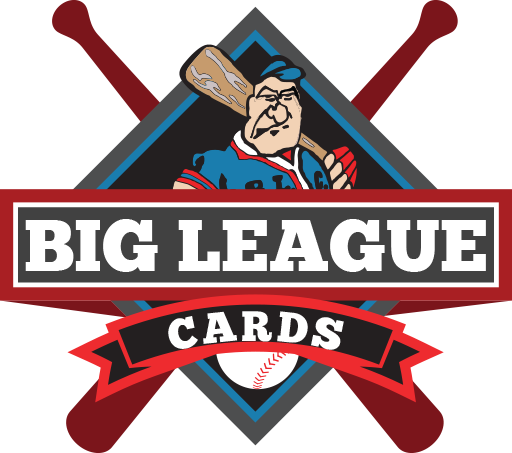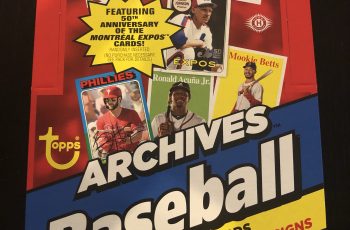Inside the Pack: Deciding to Start a Collection
If you collect anything, then at some point you made a conscious decision to start collecting it. This applies to things outside of the sports card world as well: maybe you accidentally start to accumulate something, but at some point when you realize how many you have, you either make a decision to purposely collect that item or not. When collecting sports cards, the decision is often made to collect a particular player or team or set or some other way of focusing your hobby. This year, I made a decision nearly a decade and a half too late: I decided to collect a fairly obscure and tough-to-complete autograph set from 2006.
The 2006 Fleer Greats of the Game set is a strange one, but that’s what makes it one of my favorites. After Fleer went bankrupt in 2005, Upper Deck bought the name. This was the last baseball set to use the Fleer name, and it’s wonderfully weird. At just 100 cards, the base set was easy to complete if you opened boxes, but for a set named “Greats of the Game” it certainly has some weird choices. They were great players, sure, but do Greg Luzinski and Lee Mazzilli and Randy Hundley belong in even a 200 or 300 card set with that name? And what’s with Rico Petrocelli and Andre Thornton (again, undeserving players) being the only two players not in alphabetical order on the checklist? Anyway, the design is gaudy, the player selection intriguing, and most importantly, the inserts outnumber the base set cards and are lovable in their own wacky way.
In keeping with the “Greats” theme, the set includes 9 main categories of insert sets that appear in multiple varieties: “Greats” from the Yankees, Cubs, Dodgers, Red Sox, Cardinals, Tigers, and Reds represent the team insert sets. Then there’s a Decade Greats set that highlights wonderful players based on the decade in which they played (this checklist is also alphabetical, rather than the extremely obvious way to do it, which would be, you know, by decade). But the pièce de résistance is the Nickname Greats set. While all of these insert sets have autographed versions to go along with them, the Nickname Greats set stands out for best representing the insanity of this product.
The initial beauty of the Nickname Greats set is that there are some absolutely bonkers players who would otherwise never make it into this (or any) set. Mike LaValliere had an OPS of .689 across 879 games in the 80s and 90s, but he was sometimes called Spanky, so he’s in. John Shelby and his career .645 OPS? He’s in for his nickname of T-Bone, so popular that it doesn’t even appear on his Baseball Reference page. Sparky Lyle, a terrific pitcher, is in the set, but his nickname is listed as The Count, and not, you know, Sparky, the nickname by which he’s literally known.
When I bought my first box of this product back in 2006, I pulled a Steve “Rainbow” Trout autograph, which I thought was super cool. I had no ties to Trout, but that card went right into my personal collection just for being so fun. Several months later, I asked for (and received) another box as a holiday gift. I opened it and there was another Steve Trout autograph, except this one did not say “Rainbow” on it. I fell even more deeply in love with the set right then and there.
See, the Nickname Greats autograph set is made better by all the mistakes Upper Deck made in production. Honestly, it’s hard to imagine a company that made this many mistakes in a product could even still be in operation nearly 15 years later. All the autographs in this product were sticker autographs. Some subjects had nickname autographs along with regular autographs in other insert sets. Somehow, the good folks at Upper Deck switched a bunch of the sticker sheets. This resulted in a ridiculous amount of problems in the Nickname Greats autograph set. Eight of the players don’t actually have a nickname on them, but their nicknames can be found elsewhere in the product on non-nickname autograph cards. That’s all well and good, but then several players (like Trout) have varieties that either have or do not have a nickname autograph. For Trout, the stated breakdown is 20% no nickname, 80% nickname. For others, like George Foster, the stated breakdown is 50/50.
It’s at this point in learning about the set that you realize that yes, Upper Deck did release figures regarding how many of the cards had nicknames and which did not, which means they were not only aware of the issue before release, but also took the time and energy to count the number of impacted cards. Crazily enough, though, they don’t account for everything: sometimes nickname autographs end up on regular cards, even though every nickname card has a nickname autograph. (My thinking is the player just signed too many cards with his nickname.) Sometimes there are unstated variations, like the Joe Charboneau autograph I have that does not say “Super” on it, even though the official checklist says all of his cards contain his nickname.
So, right before the pandemic started I went to a card show and purchased an Ellis Valentine autograph for $5 for my collection. During the pandemic I bought a collection that had another two nickname autographs. And suddenly I made that decision; I’d started to accumulate these, and now I was going to collect them.
It’s the perfect collection, really. It’s not so recent that all the cards are easily found. (Without a chase, I feel a collection isn’t worth my time.) It’s super weird. It’s not that huge. There are very few, if any, gigantic (and, therefore, expensive) names to chase. It’s not super hard to complete, except that there are a few difficult cards in the set, some of which I’ve literally never seen come up for sale. I’ve been plugging away at this set for months and I’m almost 60% completed.
Making a conscious decision to start a collection is always a tough one, since it presents an opportunity for both joy and spending money. This one has brought me pure joy. It brings me back to a product I loved 14 years ago and gives me memories of opening my first box in a local card shop that no longer exists, and my second box at the kitchen table of my parents’ house. It’s a fun chase, and it’s a wonderful set. I’m hoping that I don’t have too much trouble finishing it – but also hoping it’s not too easy. I’m so glad I decided to start this collection.
Next week, though, I’ll talk about making the difficult decision to pause a collection.




